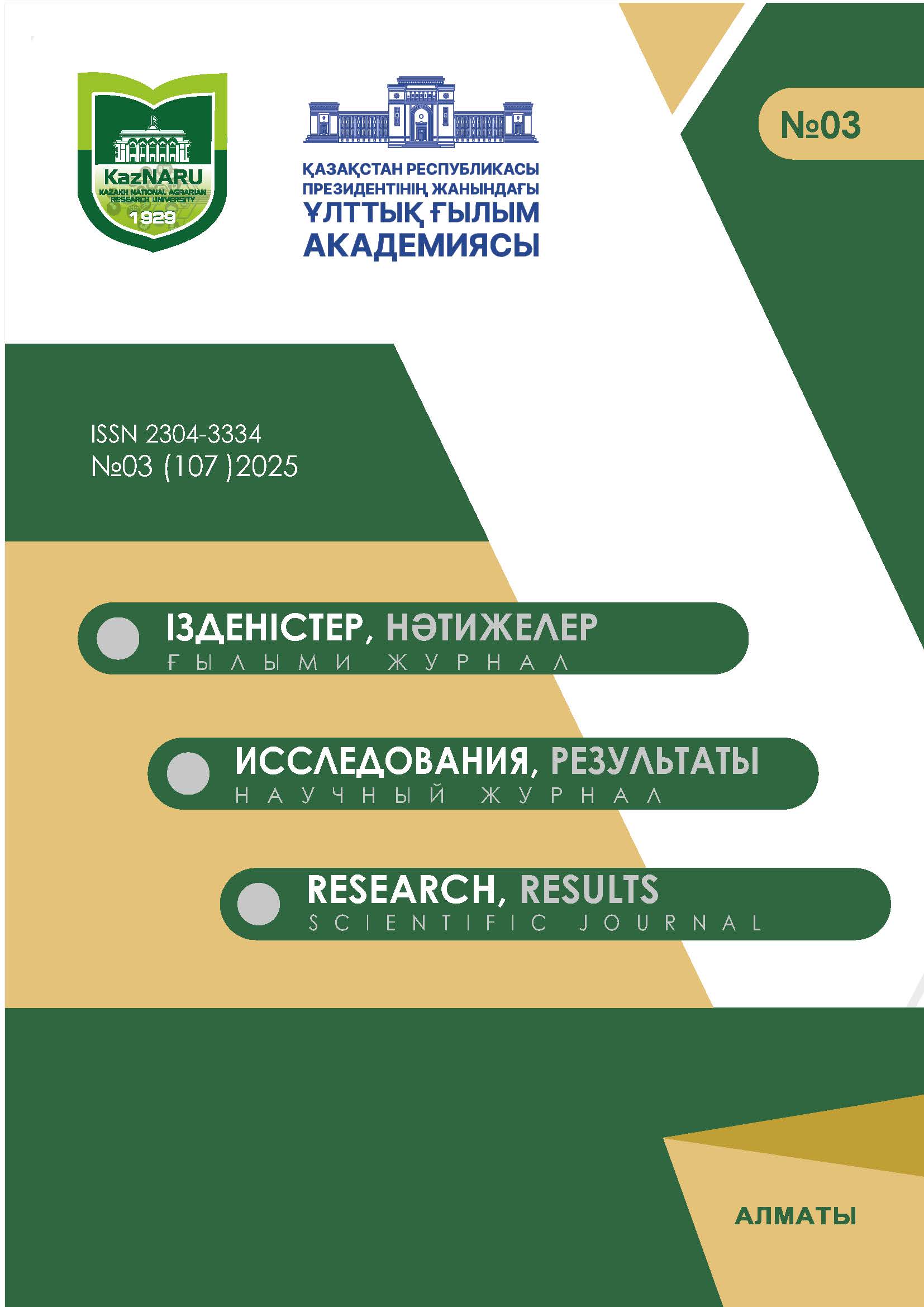ВЛИЯНИЕ НАКОПЛЕНИЯ ХЛОРОФИЛЛА В МЯГКОЙ ПШЕНИЦЕ НА УРОЖАЙНОСТЬ В ЗАВИСИМОСТИ ОТ ТЕХНОЛОГИИ ВОЗДЕЛЫВАНИЯ И ВНЕСЕНИЯ МИНЕРАЛЬНЫХ УДОБРЕНИЙ
 https://doi.org/10.37884/3-2025/12
https://doi.org/10.37884/3-2025/12
Ключевые слова:
дозы удобрений, каротиноиды, мягкая пшеница, технология возделывания, урожайность, хлорофиллАннотация
Исследования, представленные в статье направлены на изучение накопления хлорофилла и каротиноидов в зеленой массе яровой мягкой пшеницы сорта Шортандинская 95 улучшенная в различные фазы роста и развития растения в зависимости от внесения минеральных удобрений и технологии возделывания. Выбор технологии возделывания, норм внесения удобрений, сортов и предшествующих культур должен обеспечивать оптимальные условия для полноценного развития растения. Изучение хлорофилла в мягкой пшенице необходимо для оценки ее физиологического состояния, уровня фотосинтеза и способности формировать высокий и качественный урожай. В результате исследований было определено содержание хлорофилла а и b, а также каротиноидов в зеленой массе мягкой пшеницы в фазу кущения и в фазу выхода в трубку. Дaнные исследoвания позвoлят устанoвить влияниe накопления хлорофилла в мягкой пшенице на урожайность в зависимости от технoлогий возделывания и доз внесения удобрений в условиях Акмолинской области. В ходе исследований выделены варианты с внесением Р60 аф. в пар при традиционной системе земледелия в зернопаровом севообороте, Р80 аф.+ N аа в рядки по диагностике в плодосменном севообороте. При нулевой технологии возделывания в зернопаровом севообороте лучшем отмечен вариант с внесением Р20 N20 наф. в рядки, вариант Р20 аф.+ N30 аа осенью поверхностно – в плодосменном. По урожайности зерна яровой пшеницы в зависимости от способа и времени внесения аммиачной селитры в азотно-фосфорных вариантах не отмечено. Корреляционный анализ определил среднюю корреляцию по суммарному содержанию хлорофилла а и b и урожайностью не зависимо от севооборота и системы земледелия от 0,68 ед до 0,70 ед. Очень слабая корреляция получена между показателями каротиноиды и урожайность от 0,2 ед. до 0,3 ед.
Библиографические ссылки
S. Anjum, L. Wang, M. Farooq, L. Xue, S. Ali. Fulvic acid application improves the maize performance under well-watered and drought conditions, Crop Sci, 2011,Volume 197, 409–417, https://onlinelibrary.wiley.com/doi/abs/10.1111/j.1439-037X.2011.00483.x. DOI: https://doi.org/10.1111/j.1439-037X.2011.00483.x
Жумагулов И. И., Амантаев Б. О., Муханов Н. К., Кульжабаев Е. М. (2021). Влияние атмосферных осадков на урожайность яровой пшеницы и ячменя в сухостепной зоне Северного Казахстана [Текст] / И. И. Жумагулов, Б. О. Амантаев, Н. К. Муханов, Е. М. Кульжабаев // Izdenister natigeler. – 2021. -№ 3 (91). – С. 28-36, https://journal.kaznaru.edu.kz/index.php/research/article/view/49.
Zhumagulov I. I., Amantaev B. O., Muhanov N. K., Kul'zhabaev E. M. (2021). Vliyanie atmosfernyh osadkov na urozhajnost' yarovoj pshenicy i yachmenya v suhostepnoj zone Severnogo Kazahstana [Tekst] / I. I. Zhumagulov, B. O. Amantaev, N. K. Muhanov, E. M. Kul'zhabaev // Izdenister natigeler. – 2021. -№ 3 (91). – S. 28-36. [In Russian]. DOI: https://doi.org/10.37884/3-2021/04
I. Marcińska, I. Czyczyło-Mysza, E. Skrzypek, M. Filek, S. Grzesiak, M.T. Grzesiak, F. Janowiak, T. Hura, M. Dziurka, K. Dziurka. Impact of osmotic stress on physiological and biochemical characteristics in drought-susceptible and drought-resistant wheat genotypes, Acta Physiol. Plant, 2013, Volume 35, 451–461, https://link.springer.com/article/10.1007/s11738-012-1088-6. DOI: https://doi.org/10.1007/s11738-012-1088-6
A. Qayyum, S. Al Ayoubi, A. Sher, Y. Bibi, S. Ahmad, Z. Shen, M. A. Jenks. Improvement in drought tolerance in bread wheat is related to an improvement in osmolyte production, antioxidant enzyme activities, and gaseous exchange, Saudi Journal of Biological Sciences, 2021, Volume 28(9), 5238-5249, https://www.sciencedirect.com/science/article/pii/S1319562X21004071. DOI: https://doi.org/10.1016/j.sjbs.2021.05.040
A. Ullah, W. M. Al-Busaidi, A.M. Al-Sadi, M. Farooq Bread wheat genotypes accumulating free proline and phenolics can better tolerate drought stress through sustained rate of photosynthesis, Journal of Soil Science and Plant Nutrition, 2021, Volume 22(1), 165-176, https://link.springer.com/article/10.1007/s42729-021-00641-7. DOI: https://doi.org/10.1007/s42729-021-00641-7
M.A. Shalaby, M.A. Ahmed, M.A. Khater Physiological responses of some barley cultivars to foliar treatments with arginine under water stress conditions, Middle East J. Agric. Res, 2018, Volume 7, 1102–1123, https://www.curresweb.com/mejar/mejar/2018/1102-1123.
M. Hasanuzzaman, K. Nahar, A. Rahman, M. Inafuku, H. Oku, M. Fujita Exogenous nitric oxide donor and arginine provide protection against short-term drought stress in wheat seedlings, Physiol. Mol. Biol. Plants, 2018, Volume 24, 993–1004, https://www.curresweb.com/mejar/mejar/2018/1102-1123. DOI: https://doi.org/10.1007/s12298-018-0531-6
H. A. Hussein, S. O. Alshammari, S. K. Kenawy, F. M. Elkady, A. A. Badawy Grain-priming with L-arginine improves the growth performance of wheat (Triticum aestivum L.) plants under drought stress, Plants, 2022, Volume 11(9), 1219, https://www.mdpi.com/2223-7747/11/9/1219. DOI: https://doi.org/10.3390/plants11091219
Z.H. Hamid, M. Amer, A. Wahab. Effect of arginine on growth and yield of tomato plant (Lycopersicon esculentum) under drought stress, Plant Arch, 2021, Volume 19, 4441–4444, https://search.ebscohost.com/login.aspx?direct=true&profile=ehost&scope=site&authtype=crawler&jrnl=09725210&AN=142531329&h=5pkFJaVZR1D8YtM5AzGqUZbBHtq6Pqvhx62tvY18X%2FIqYm2H1Pm5Z4U9qzLMrJWXsHrfNv9%2F4Pc3H%2BW%2BJRk1IQ%3D%3D&crl=c.
H.M. Kalaji, A. Rastogi, M. Zivcak, M. Brestic, A. Daszkowska-Golec, K. Sitko, K.Y. Alsharafa, R. Lotfi, P. Stypinski, I.A. Samborska, M.D. Cetner. Prompt chlorophyll fluorescence as a tool for crop phenotyping: an example of barley landraces exposed to various abiotic stress factors, Photosynthetica, 2018, Volume 56 (3), 953-961, https://link.springer.com/article/10.1007/s11099-018-0766-z. DOI: https://doi.org/10.1007/s11099-018-0766-z
H. Janeckova, A. Husickova, D. Lazar, U. Ferretti, P. Pospisil, M. Spundova. Exogenous application of cytokinin during dark senescence eliminates the acceleration of photosystem II impairment caused by chlorophyll b deficiency in barley, Plant Physiology and Biochemistry, 2019, Volume 136, 43-51. Doi.10.1016/j.plaphy.2019.01.005/. DOI: https://doi.org/10.1016/j.plaphy.2019.01.005
O.V. Voitsekhovskaja, E.V. Tyutereva. Chlorophyll b in angiosperms: Functions in photosynthesis, signaling and ontogenetic regulation, Journal of Plant Physiology, 2015, Volume 189, 51–64. http://dx.doi.org/10.1016/j.jplph.2015.09.013. DOI: https://doi.org/10.1016/j.jplph.2015.09.013
Jie He, Wenquan Yang, Lin Qin, Da-Yong Fan, Wah Soon Chow. Photoinactivation of Photosystem II in wild-type and chlorophyll b-less barley leaves: which mechanism dominates depends on experimental circumstances, Photosynth Res, 2015, Volume 126, 399–407, https://link.springer.com/article/10.1007/s11120-015-0167-0. DOI: https://doi.org/10.1007/s11120-015-0167-0
L. Ren, H. Ma, D. Chao, H. Zhang, K. Qiao, S. Feng, A. Zhou. Sep2, a light-harvesting complex-like protein, is involved in light stress response by binding to free chlorophylls. Environmental and Experimental Botany, 2023, Volume 213, 105429, https://www.sciencedirect.com/science/article/pii/S0098847223002241. DOI: https://doi.org/10.1016/j.envexpbot.2023.105429
E. A. Sharlaeva, V. Y. Chirkova, V. S. Bublik. Studying the possibility of using uv-c radiation to improve seedling qualities and increase the productivity of soft spring wheat, AIP Conference Proceedings, 2022, Volume 1, 2390, https://pubs.aip.org/aip/acp/article-abstract/2390/1/030080/2820394. DOI: https://doi.org/10.1063/5.0069976
L. Begovic, C. V. Galic, I. Abicic, Z. Loncaric, A. Lalic, S. Mlinaric. Implications of intra-seasonal climate variations on chlorophy ll a fluorescence and biomass in winter barley breeding program, Рhotosynthetica, 2020, Volume 58 (4), 995-1008, https://ps.ueb.cas.cz/pdfs/phs/2020/04/12.pdf, Doi: 10.32615/ps.2020.053. DOI: https://doi.org/10.32615/ps.2020.053
A. Guizani, H. Askri, M. L. Amenta, R. Defez, E. Babay, C. Bianco, F. Gharb. Drought responsiveness in six wheat genotypes: identification of stress resistance indicators, Frontiers in Plant Science, 2023, Volume 14, 1232583, https://www.frontiersin.org/journals/plant-science/articles/10.3389/fpls.2023.1232583/full. DOI: https://doi.org/10.3389/fpls.2023.1232583
J. Fu, S. V. Krishna Jagadish, R. L. Bowden. Effects of post‐flowering heat stress on chlorophyll content and yield components of a spring wheat diversity panel, Crop Science, 2022, Volume 62(5), 1926-1936, https://acsess.onlinelibrary.wiley.com/doi/abs/10.1002/csc2.20778. DOI: https://doi.org/10.1002/csc2.20778
V. I. Trukhachev, I. I. Seregina, S. L. Belopukhov, I. I. Dmitrevskaya, T. I. Fomina, O. A. Zharkikh, D. M. Akhmetzhanov. The effect of stressful ecological conditions on chlorophyll content in the leaves of spring wheat plants, In IOP Conference Series: Earth and Environmental Science, 2022, Volume 981(3), 032093, https://iopscience.iop.org/article/10.1088/1755-1315/981/3/032093/meta. DOI: https://doi.org/10.1088/1755-1315/981/3/032093
A. Sevda, M. Sevinj, Z. Atif, I. Irada. Morphophysiological parameters of hard and soft wheat genotypes depending on different water supply, Бюллетень науки и практики, 2023, Volume 9(4), 113-120, https://cyberleninka.ru/article/n/morphophysiological-parameters-of-hard-and-soft-wheat-genotypes-depending-on-different-water-supply. DOI: https://doi.org/10.33619/2414-2948/89/14
Загрузки
Опубликован
Как цитировать
Выпуск
Раздел
Лицензия
Copyright (c) 2025 Izdenister natigeler

Это произведение доступно по лицензии Creative Commons «Attribution-NonCommercial» («Атрибуция — Некоммерческое использование») 4.0 Всемирная.






